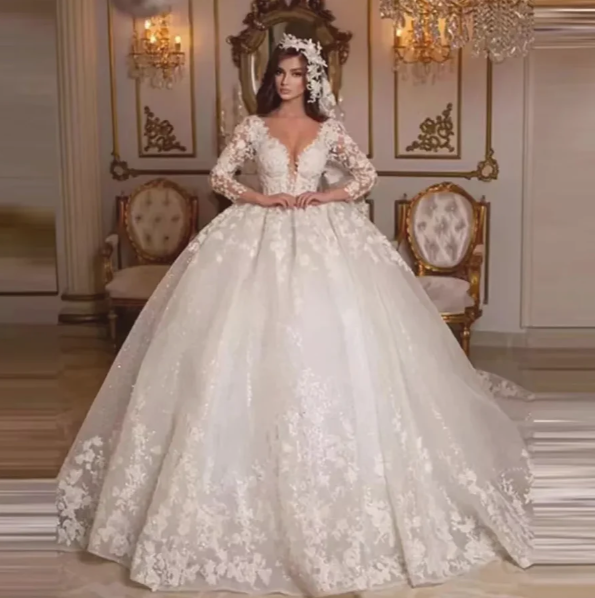Arabian Bridal Dress: A Symbol of Elegance, Heritage, and Royal Glamour

In the vast tapestry of global bridal fashion, few styles capture the imagination and opulence of culture quite like the Arabian bridal dress. Rooted in centuries of tradition and enriched by regional diversity, the Arabian bridal ensemble is more than just a wedding gown — it is a cultural statement of beauty, luxury, and honor. From shimmering gold threads to intricate beadwork and flowing silhouettes, Arabian bridal dresses reflect a bride’s identity, her family’s heritage, and the grandeur of Middle Eastern artistry.
1. The Cultural Essence of the Arabian Bridal Dress
The Arabian bridal dress is a mesmerizing blend of tradition and modernity, echoing the deep respect for culture that runs throughout Arab societies. Each region within the Arab world — from Saudi Arabia and the UAE to Lebanon, Jordan, and Morocco — has its unique interpretation of bridal attire. Yet, the underlying philosophy remains the same: to make the bride appear regal, radiant, and divine.
Historically, bridal garments in Arabia were heavily influenced by Bedouin customs and Islamic values, emphasizing modesty while showcasing fine craftsmanship. Over time, these traditions evolved with Persian, Ottoman, and Indian influences, introducing luxurious fabrics like silk, satin, and velvet, adorned with gold and silver embroidery. The result is a timeless ensemble that celebrates femininity, grace, and cultural pride.
2. The Design Philosophy: Opulence in Every Thread
At the heart of every Arabian bridal dress lies the artistry of intricate design. Designers focus on details that symbolize wealth, purity, and spiritual blessings. Common features include:
-
Heavy Embroidery: Gold and silver threads, known as zari or talli, form exquisite floral and geometric patterns inspired by Islamic art.
-
Swarovski Crystals and Beads: Modern Arabian gowns often feature hand-embroidered crystals and sequins, creating an ethereal glow under the wedding lights.
-
Flowing Silhouettes: Most dresses feature long trains, cape-like sleeves, or layered skirts, enhancing the bride’s majestic presence.
-
Luxurious Fabrics: Silk, chiffon, brocade, and organza are among the most popular materials, chosen for their softness, shine, and ability to drape gracefully.
Unlike Western wedding gowns that typically favor simplicity and white hues, Arabian bridal dresses embrace boldness and glamour. They often combine rich colors, gold accents, and voluminous designs, giving the bride an unmistakable aura of royalty.
3. Colors and Symbolism in Arabian Bridal Fashion
In Arabian culture, color holds deep symbolic meaning. The traditional white wedding gown has gained popularity in urban settings due to Western influence, yet many brides continue to honor their roots through colorful dresses that represent joy, prosperity, and love.
-
Gold and Champagne: Represent wealth, success, and divine light.
-
Red: Symbolizes love, passion, and strength — a favorite choice for Moroccan and Lebanese brides.
-
Emerald Green: Associated with growth, faith, and fertility, often linked to Islamic heritage.
-
Royal Blue and Purple: Stand for nobility and power, worn by brides who desire a majestic appearance.
These vibrant tones are often paired with shimmering jewelry and headpieces, creating a visual harmony that reflects both modern beauty and cultural authenticity.
4. The Traditional “Thobe” and Regional Variations
The Arabian bridal dress takes on many forms across different Arab countries, each carrying a distinct identity:
-
Saudi Arabia: Brides often wear a heavily embellished thobe nashal, a traditional long robe made from luxurious fabric, hand-embroidered with gold threads. It is usually paired with ornate jewelry and a modest veil.
-
United Arab Emirates: The jalabiya and abaya-style wedding dresses are popular, merging modern couture with traditional modesty. Emirati designers often use French lace, pearls, and crystals to achieve a regal effect.
-
Lebanon and Syria: Known for their fashion-forward brides, Lebanese designers like Elie Saab and Zuhair Murad have revolutionized Arabian bridal couture by combining Western silhouettes with Middle Eastern embellishments.
-
Morocco: The Moroccan kaftan and takchita are iconic. These layered dresses, secured with ornate belts and decorated with intricate embroidery, create a graceful, queenly appearance.
-
Egypt and Jordan: Brides often choose dresses with delicate beadwork, flowing trains, and elegant veils that reflect both Islamic modesty and Mediterranean beauty.
Each region’s style contributes to the diverse and evolving identity of Arabian bridal fashion — making it a true reflection of cultural fusion.
5. Accessories: Completing the Royal Look
An Arabian bride’s attire is incomplete without her accessories, each piece chosen to complement the magnificence of the gown. Traditional accessories often include:
-
Headpieces (Tiaras or Crowns): Symbolizing grace and authority, often embellished with pearls, diamonds, or gold.
-
Veils: Ranging from simple chiffon coverings to heavily beaded veils that trail behind the bride, symbolizing purity and modesty.
-
Gold Jewelry: In many Arab weddings, gold is not only decorative but also a form of financial security. Necklaces, bracelets, and earrings are gifted by family members as a sign of love and blessing.
-
Henna: Before the wedding, brides adorn their hands and feet with intricate henna patterns, believed to bring good luck and ward off evil.
Together, these accessories turn the Arabian bride into a living masterpiece of tradition, love, and spirituality.
6. Modern Interpretations and Global Influence
In today’s fashion world, the Arabian bridal dress has transcended borders. International designers are inspired by its ornate craftsmanship, modest elegance, and rich storytelling. Global celebrities and royalty have embraced Middle Eastern aesthetics, showcasing Arabian-inspired gowns on red carpets and royal weddings.
Contemporary brides now seek the perfect balance between heritage and innovation — choosing dresses that maintain traditional embroidery while featuring modern silhouettes, lighter fabrics, and minimalistic designs. Designers like Reem Acra, Elie Saab, and Huda Al Nuaimi have played key roles in redefining what it means to be an Arabian bride in the 21st century.
Social media has also fueled this evolution. Platforms like Instagram and TikTok feature brides from Dubai, Riyadh, and Beirut showcasing stunning dresses that blend cultural pride with cosmopolitan taste, inspiring women worldwide to embrace Arabian luxury.
7. The Symbolism Behind the Arabian Bridal Dress
Beyond beauty and craftsmanship, the Arabian bridal dress holds spiritual and emotional significance. It represents a woman’s transition from daughter to wife — a sacred journey celebrated with honor, modesty, and joy. Every bead, thread, and stitch tells a story of heritage, faith, and family unity.
The grandeur of the dress also mirrors the importance of weddings in Arab culture — not merely as a union of two individuals but as a celebration of community, lineage, and divine blessings. The bride’s attire becomes a visual representation of her family’s love, her culture’s strength, and her own personal grace.
8. Conclusion: The Eternal Charm of Arabian Bridal Beauty
The Arabian bridal dress stands as one of the most breathtaking expressions of global bridal artistry. It combines tradition, faith, and sophistication in a way that few other styles can. From the shimmering gold embroidery of a Saudi thobe nashal to the radiant elegance of a Lebanese couture gown, each dress embodies the soul of the Middle East — where heritage meets modern glamour.
For the Arabian bride, her wedding day is not just a celebration of love — it is a testament to her culture’s timeless elegance. And as designers continue to reinvent this classic art form, the Arabian bridal dress will forever remain a symbol of beauty, identity, and everlasting grace.



